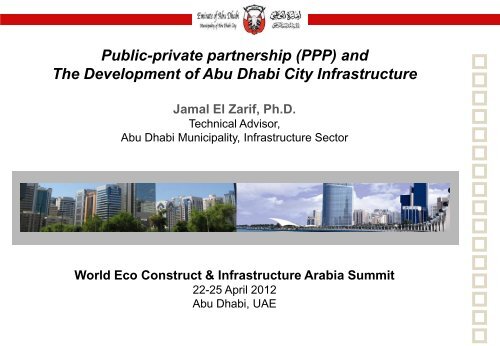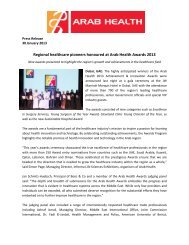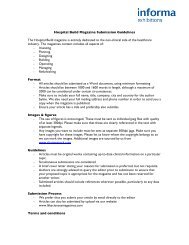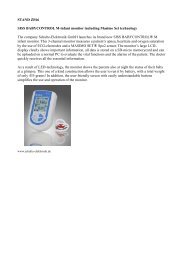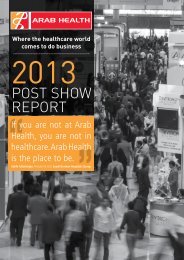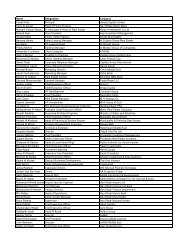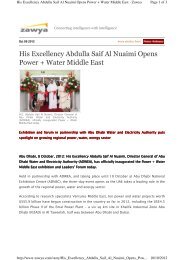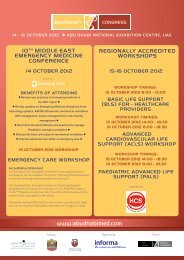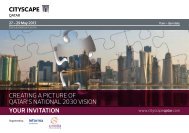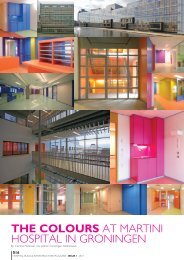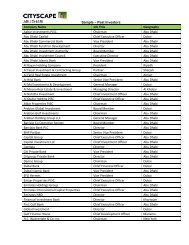Abu Dhabi Municipality - IIR Middle East
Abu Dhabi Municipality - IIR Middle East
Abu Dhabi Municipality - IIR Middle East
Create successful ePaper yourself
Turn your PDF publications into a flip-book with our unique Google optimized e-Paper software.
<strong>Abu</strong> <strong>Dhabi</strong> 2030 Economic Vision<strong>Abu</strong> <strong>Dhabi</strong>’s Seven Areas of Ongoing Economic Policy Focus1. Build an Open, Efficient, Effective and Globally Integrated Business Environment2. Adopting Disciplined Fiscal Policies that are Responsive to Economic Cycles3. Establish a Resilient Monetary and Financial Market Environment withManageable Levels of Inflation4. Drive Significant Improvement in the Efficiency of the Labour Market5. Develop a Sufficient and Resilient Infrastructure Capableof Supporting Anticipated Economic Growth6. Develop a Highly Skilled, Highly Productive Workforce7. Enable Financial Markets to Become the Key Financiers ofEconomic Sectors and Projects
<strong>Abu</strong> <strong>Dhabi</strong> 2030 Infrastructure Requirements
Municipal System & PPP• DMA hosted the first municipal forum for its strategic private partners inJanuary 2010• <strong>Abu</strong> <strong>Dhabi</strong> Government issued a directive in 2011 to explore the PublicPrivate Partnership opportunities• 2011 PPP <strong>Middle</strong> <strong>East</strong> Conference is a natural progression of DMA’sdesire to engage with the private sector• DMA recognises the potential of private sector involvement in Municipalprojects in terms of:1. attracting private capital investment2. increasing efficiency and use available resources more effectively; and3. reforming sectors through a reallocation of roles, incentives, and accountability.
Defining Public-Private Partnerships (PPPs)• It is a contractual agreement between a public agency (ADM)and a private sector entity, where ADM retains the ownershipof assets while the private party is given additional decisionmaking rights in determining how the project and tasks will becompleted• Through this agreement, the skills and assets of each sector(public and private) are shared in delivering a service or facilityfor the use of the general public.• In addition to the sharing of resources, each party shares in therisks and rewards potential in the delivery of the service and/orfacility. The goal is to combine the best capabilities of the public andprivate sectors for mutual benefit.
Our PPPs (Concessions) are about:1. Mobilising private sector’s money, expertise and capacities forinfrastructure development2. Long-term relationship between government and private sector(usually>10years)3. Sharing of Risks and Rewards (no lop-sided agreementsprivatizingthe profits, nationalizing the loses)4. Private sector performs to agreed KPIs5. Life cycle focus (operations and maintenance)
Advantages of PPPs in Relationto Traditional Public FundingGovernment:• To aide in closing the infrastructure gap• Supplement public funding--not supplant it• To bring additional revenue to public infrastructure• Continue to advocate increasing public investmentInvestors:• Attraction is long-term, secure, protected investmentsEnd Users:• PPP results in accessible, affordable and safe servicesthat meet acceptable standards of quality
Added Value for ADM by procuring through PPP
Time OverrunsPPP Financing vs. Government FinancingCostOverrunsPayment linked toKPI’s for Availability& Service DeliveryReplacement Cost ‘Spikes’EstimatedCapitalCostRunning Cost OverrunsEstimated Running CostNoPaymentUntilFacilitiesdeliveredPayment Based on Service/UsagePayment Based on AvailabilityYears 5 10 15 20 25ConstructionTraditional ProcurementOperations & Maintenance1. Capital costs & Operating costs are paid asthey are incurred2. Disconnect between design, build &operations3. Risk of cost & time overruns4. Operational budgeting is exposed to cost‘spikes’ from planned & unplanned majorinterventions,5. Focus on construction and operationsresulting in distraction from core activitiesYears 5 10 15 20 25ConstructionOperationsPPP Procurement1. Payments are made once the facility is available to thespecified standard2. Payment is spread over agreed concession term, withbudget forecast certainty.3. Revenue are dependant on availability, quality ofservices (linked to KPI’s).4. Economic Optimisation; life cycle cost, design &operation5. Focus on life of asset cost planning, Government canconcentrate on ‘core’ activities
Design-Build (DB): The private sector designs and builds infrastructure to meet public sector performance specifications, often for a fixedprice, turnkey basis, so the risk of cost overruns is transferred to the private sector. (Many do not consider DB's to be within the spectrum ofPPPs and consider such contracts as public works contracts.)ADM is open to examine specific projects for an appropriate model which brings demonstrable VALUEWhich PPP Model for ADM Projects?Buy-Build-Operate (BBO): Transfer of a public asset to a private or quasi-public entity usually under contract that the assets are to beupgraded and operated for a specified period of time. Public control is exercised through the contract at the time of transfer.Build-Own-Operate (BOO): The private sector finances, builds, owns and operates a facility or service in perpetuity. The public constraintsare stated in the original agreement and through on-going regulatory authority.Build-Own-Operate-Transfer (BOOT): A private entity receives a franchise to finance, design, build and operate a facility (and to chargeuser fees) for a specified period, after which ownership is transferred back to the public sector.Build-Operate-Transfer (BOT): The private sector designs, finances and constructs a new facility under a long-term Concession contract,and operates the facility during the term of the Concession after which ownership is transferred back to the public sector if not alreadytransferred upon completion of the facility. In fact, such a form covers BOOT and BLOT with the sole difference being the ownership of thefacility.Build-Lease-Operate-Transfer (BLOT): A private entity receives a franchise to finance, design, build and operate a leased facility (and tocharge user fees) for the lease period, against payment of a rent.Design-Build-Finance-Operate (DBFO): The private sector designs, finances and constructs a new facility under a long-term lease, andoperates the facility during the term of the lease. The private partner transfers the new facility to the public sector at the end of the leaseterm.Finance Only: A private entity, usually a financial services company, funds a project directly or uses various mechanisms such as a longtermlease or bond issue.Operation & Maintenance Contract (O & M): A private operator, under contract, operates a publicly owned asset for a specified term.Ownership of the asset remains with the public entity. (Many do not consider O&M's to be within the spectrum of PPPs and consider suchcontracts as service contracts.)
ADM Challenges for Implementing PPP Framework1. Establishing regulatory framework2. Engaging adequate level of the Private Sector interest3. Identifying a model for non-revenue generating assets4. Establishing Procurement Process for PPP in ADM5. Performing feasibility study and demonstrating the addedvalue of the PPP route6. Ensuring PPP route is competitive compared totraditional, (not inflated due to risk transfer).
Community Benefits• Accelerated Community assets delivery without increasingGovernment Annual Capital Expenditure• Projects delivered earlier for community benefit• Improved Value for Money in delivering Community Assets• Communities environments & facilities enhanced• Enhanced Operation & Maintenance of Community AssetsPrivate Sector Benefits• Creating new opportunities• Potentially accelerating project roll-out• Creating long term investment opportunities• Long term revenue streams
Overview of <strong>Abu</strong> <strong>Dhabi</strong>Current and Potential PPP ProjectsDifferent Type of Projects that could range from a limited smallproject to a full infrastructure upgrade programCurrent PPP projects• Universities campus• Al Dhafra recycling• Parking and Corniche ProjectsPotential ADM projects• Street Lighting LED Retro-fit• <strong>Abu</strong> <strong>Dhabi</strong> Gate Beach (Between Two Bridges)• The Infrastructure Development Program of 3 Cities
Examples of <strong>Abu</strong> <strong>Dhabi</strong> PPP ProjectsMubadala has successfully initiated severalPPP projects• UAE University – Al Ain• Sheikh Zayed University• Sorbonne University
<strong>Abu</strong> <strong>Dhabi</strong> PPP ProjectsCentre of WasteManagement <strong>Abu</strong> <strong>Dhabi</strong>Al Dhafra Construction &Demolition WasteRecycling FacilityConcessionDOT – ADM Project, On-streetParking• Privately financed• Payback 7 years• Includes SAEED service
<strong>Abu</strong> <strong>Dhabi</strong> PPP ProjectsADM Corniche Public BeachOperation & Maintenance Contract
ADM Potential Projects:Street Lighting RetrofitTotal CostAED 150million•A long-term (10 -year) contract to be signed with a consortium (supplier andlender) for replacement and maintenance of new lighting facilities•The supplying company has to replace discharge type (like HPS lamp) withpower saving LED luminaires• The financial entity to finance capital and maintenance costs• Cost recovery is made through fixed payments made by ADM out of O&Msavings incurred27
• Project will be implemented in three phases.• Total Implementation of the project will bethrough Private Sector funding.• Policies and Regulation will be conducted byGovernment.• Investment return will be through the right toexploit the retails and public facilities.Streetscape, Surface Parking & Retail in <strong>Abu</strong> <strong>Dhabi</strong> Gate (B2B)•The objectives are to create an attractive, accessible andhospitable public realm based on a multi-layered publictransport network with pedestrian amenity as well as anetwork of interconnected public spaces and routes.•A range of policies and guidance strategies have beenimplemented to ensure that future development isenvironmentally, economically, culturally and sociallysustainable.Total CostAED 200million
KCACapitalDistrictKCBMBZImplementing 3 CitiesKhalifa Cities A & B,Mohammed Bin Zayed City
KCAKCBMBZPublic - OccupiedVilla – Built or UnderConstructionPublic - VacantVilla - Vacant• Extensive build-out and rapid growth• Insufficient infrastructure for future needs• Limited public amenitiesPROJECT RATIONALE
Urban Environment & Public Infrastructure Upgrades, 2012-2021• Provide high quality of life for the growing population of the 3 Cities• Maximize municipal investment value• Apply “Best Practices” in environment and sustainabilityPROJECT OBJECTIVES
Khalifa bin Zayed City A Infrastructure Requirements• 22.9 million m2 total land area• 42 Sectors• 147 Public Plots in addition to 391 nonvillaplots• 3,686 Villa Plots• 2,703 Villa Plots are built or underconstruction which represent 73% of thetotal Villa Plots• 5 Work Zones• 12.8 million m2 allocated land per GFA& Population Report• 12.6 million m2 GFA per GFA Report• 3.33 million m2 streetscape• 0.33 million m2 of parks, 32 Parks(not incl. ROW Parks)• 195 km of roads• Estimated 250 km of Sikkas(38 km developed for budget)• Estimated 9,021 street/ pedestrianlights• Estimated current population: 50,574• Estimated full population: 194,348 perapproved GFA & Population Report
Khalifa bin Zayed City B Infrastructure Requirements• 18.5 million m2 total land area• 12.8 million m2 GFA per GFA Report• 42 Sectors• 596 Public Plots in addition to 309 nonvillaplots• 3,165 Villa Plots• 1294 Villa Plots are built or underconstruction which represent 42% of thetotal Villa Plots• 3 Work Zone• 7.3 million m2 allocated land per GFA &Population Report• 3.7 million m2 streetscape• 1.15 million m2 of parks, 131 parks(not incl. 60 ROW parks)• 190 km of roads• Estimated 192 km of sikkas(19 km to be developed per budget)• Estimated 10,027 street/ped. lights• Estimated current population: 18,318• Estimated full population: 175,017 perapproved GFA & Population Report
Mohammed bin Zayed City Infrastructure Requirements
Note:Public Realm Consultant procurement,Design & Project Procurement period areincluded in the respective RoadsInfrastructure Upgrade packages.MBZ SUMMARY MASTER SCHEDULE
Outline of Performance Criteria:KPIs of Infrastructure and Public Realm1. Customer Service• Help Desk response times,• HS&E reporting: accidents etc• Annual satisfaction surveysOffice waiting times, Office open hours,Quality : low level of complaints2. Estate & Environmental• Estate inspections: frequency &% actions cleared• Weekly inspections: cleaning standards external and internal areas• Maintenance of external open areas: soft& hard landscaping, playgrounds, etc.• Removal of abandoned vehiclesRemoval of graffiti• Pest controlWaste management• Utility and Energy management3. Repairs and Maintenance• Responsive Repairs: emergency, urgent, non-urgent• Cyclical maintenance• Planned maintenance• Night reporting of defective lightingM&E maintenanceAvoid repeat visits for repairsCommon areas tested and maintained% of street lights on
What PPP ADM is Looking For ?
What ADM is looking forby introducing PPP in Infrastructure Delivery• Allow the costs of investment to be spread over the lifetime ofthe asset.• Have a solid track record of on-time, on-budget delivery.• Transfer certain risks to the private sector and provideincentives for assets to be properly maintained.• Lower the cost of infrastructure to the public entity by reducingboth construction costs and overall life-cycle costs.• Encourage a strong customer service orientation (satisfactionmetrics KPI to be built into the contract).• ADM to partially move from role of Developer & Operator toFacilitator (and Governing)
Where are we now?PPP LifecyclePreparing and Implementing Efficient PPP TransactionDevelopmentPhaseProcurementPhaseImplementationPhaseNeeds AnalysisPPP Option AppraisalValue for MoneySustainabilityPreliminary Risk MatrixViability/BankabilityEC ApprovalTransaction AdvisorEOI and RFPBiddingBidders ConferenceBid EvaluationPreferred Bidder SelectionFull Business CasePPP agreementEC ApprovalTechnical AdvisorMonitor DesignMonitor ConstructionCommissioning testOutput VerificationContract management
Next StepsDeveloping a WIN-WIN Scenario• ADM has assigned a Task Team to Investigate PPPOpportunities• ADM PPP Task Team – Identify potential projects, identifyappropriate PPP model, defining criteria to assess projectsuitability for PPP, Value added analysis, risk analysis, legal ®ulatory gap analysis et al.• Private Sector can request ADM Task Team to meet anddiscuss projects in order to identify potential areas ofcooperation.
Thank You41


